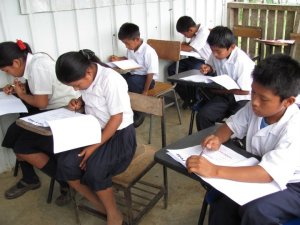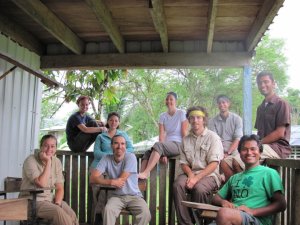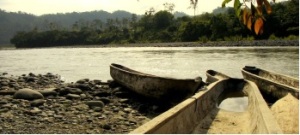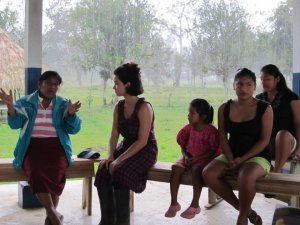The Naso
The Naso (known as Teribe to outsiders) are a tribal group in western Panama settled along the Teribe River which empties into the Caribbean Sea. Their indigenous way of life is endangered in several dimensions. Out of an ethnic population of 3,500, only 500 are estimated to speak the Naso language. Half of their territory has been delimited as a National Park and the other half as Collective Property by the Panamanian government, leaving them without title of the land they have inhabited for thousands of years. Other indigenous groups and Latinos have intermarried with them and brought different languages. A controversial hydroelectric energy plant has moved the outside world to the heart of their land. Public education, religious services, and media come in Spanish. All of these factors threaten the vitality of the language.
The Naso community is gravely concerned that the young have lost their language and that the culture will disappear. Compulsory elementary education in Spanish, the dominance of Spanish in religious activities, and trade with Panamanian towns are all recent emerging dangers to the authority and vitality of Naso. More recently, in 2004, language loss has been catalyzed exponentially by the development of the Bonyic Hydroelectric Plant project in the Teribe area. Because the Naso are the only indigenous group in Panama without official territory rights to their land, they fear that foreigners will appropriate and settle in the area when the plant is completed and the land increases in value and business activity.
My Introduction to the Naso
In June 2010, during the implementation trip of Engineers Without Borders‘ Panama Water and Sanitation project in Sieykin, I discussed with local teachers about the state of the Naso language. The teachers expressed their deep concerns about the drastic loss of their indigenous language due to outside influences and their inability of conserving the language, and thus their culture, due to limitation of resources. I discussed this with local community leaders, who then expressed interest for a Naso language and culture preservation project.
Upon returning from the trip, I contacted the Endangered Language Alliance (ELA) relaying the concerns of the Naso tribesmen of the loss of their language. As a volunteer at ELA and an experienced fieldworker of other indigenous communities in Panama, Natalia Bermudez looked for an opportunity to begin a documentation project for the Naso. The Gesselschaft fur Bedrohte Sprachen (GBS) provided funding for the first Naso documentation project trip during January 2011. Natalia and I traveled to Panama in January 2011 for the first part of the documentation project.
Project Description
DOCUMENTING NASO: A DISAPPEARING LANGUAGE IN PANAMÁ (Natalia Bermudez)
When navigating up-river and into the jungle one passes eleven villages. Along the journey, one can observe women washing clothes on river bends and children searching for crawfish under rocks. After canoeing for three hours the last stop is Sieykjing, the main community where the Naso language is still spoken.
The arrival of an outsider elicits questions. What are you doing here? Where will you stay? How did you learn about us? How will your project benefit us? Throughout history outsiders have brought new ideologies, religions, governance structures, or executed privately funded projects. Like many other indigenous groups in Central and South America, the present day Naso’s introduction to outsiders was with missionaries. The most recent group came in the 1970s and stayed until 2010. When they left, the Naso voiced regret; while the missionaries learned Naso and translated the Bible to the indigenous language, the Naso felt they hadn’t learned new skills. Although the goals of Bible-translating missionaries and language preservationists are very different, they both come as outsiders to learn the language and produce written materials. It was important for my project to be a collaborative effort that prioritized the needs of the Naso.
The Naso tribe has a king as the formally recognized authority. In practice, each Naso clan (or extended family) labors independently as a group. When I introduced my project in a community meeting, each family preferred to work separately. Nevertheless the goal of each group was the same: to conserve traditions within their families through audiovisual recordings of elders.
Thirteen elders from different families participated. Represented in the array of projects were the diversity of skills and knowledge of each clan. Material ranged from performance of song and dance, knowledge of medicinal plants, names of river tributaries, wood-working techniques, stories and myths and agriculture traditions.
For every elder recorded, relatives learned technology and methods of documentation. About 20 students were trained in basic computer skills and a few in handling recording devices. I taught them how to transcribe and translate audio material in order to build subtitles for videos and texts that were printed.
During my second fieldtrip in 2011, I witnessed how the Naso underwent a change in leadership and elected a new king with a platform that values preservation of cultural traditions and language. Prospects of working with the new king are heartening; the plan to build a Cultural Educational Center in each Naso community directly supports the creation of educational materials to distribute and teach to students.
A Naso Culture book is in the making and is to include history, folklore, traditional practices, and other knowledge. Other prospects include a Culture Class led by volunteer Nasos, a literacy workshop co-hosted with Chibchan linguist J.D. Quesada, and archiving recordings of each family at the Cultural Education Centers in each Naso community.




